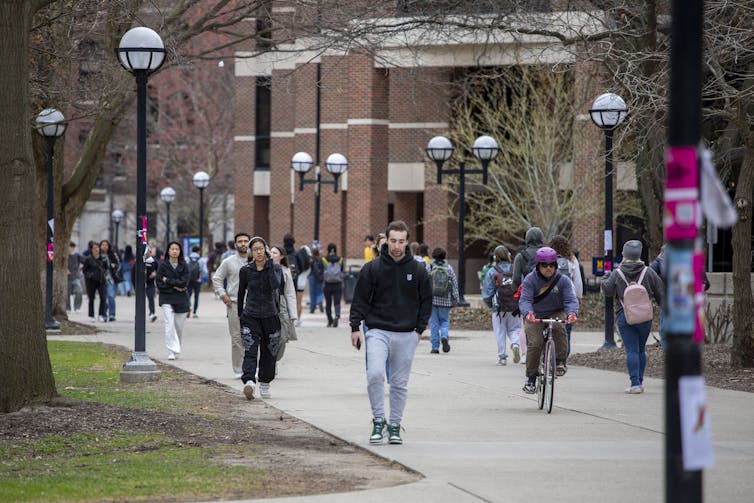Source: The Conversation – Africa (2) – By Oluwaseyi Omowunmi Popogbe, Lecturer, Crawford University
Millions of people in Lagos live in slums. Slums typically have poor housing infrastructure and sanitation, and limited access to education, health facilities and clean drinking water.
These challenges make the people who live in slums vulnerable to health crises, high illiteracy rates and poor standards of living.
A central element of the city authorities’ efforts to address the issue has been to evict people. Over the past decade, more than 50,000 people have been evicted from their homes in Lagos slums.
As a development economist who has carried out studies on urban poverty in Lagos State and social exclusion of slum dwellers from full communal participation, I have observed some notable patterns.
Despite their efforts to contribute to national productivity, these low-income communities are often marginalised and denied access to basic public amenities and a dignified living environment. Instead of addressing their needs, policy and development priorities tend to focus on displacing them. Thereafter, provisions are made for affluent groups, replacing informal settlements with high-rise buildings.
Sadly, survivors of forced eviction usually move to other slum communities as they cannot afford the high cost of living in the city. This shows that forced eviction is not a solution to slum proliferation.
I argue that if Lagos wants to solve the problems faced by the city’s vast population of slum dwellers, it should focus on six things. These are:
-
community-led regeneration processes
-
communal engagement
-
upgrading communities without displacement
-
obeying court orders
-
inclusivity in regeneration
-
adequate compensation to the displaced.
This would help restore trust that the city has all its people’s interests at heart, not just those of the super rich.
Forced evictions are seen as benefiting the rich
In March 2025, a demolition exercise was carried out in the Otumara slum, displacing over 10,000 residents at short notice.
Despite a 2017 Lagos State High Court ruling which condemned forced evictions carried out without due consultation, they have continued.
Known cases are the Otodo-Gbame waterfront eviction (shortly before the court ruling), where over 30,000 residents were displaced, Ilubirin waterfront community, Orisunmibare in Apapa, Otto communities, Ayetoro, and Oko Baba communities.
Mid-April 2025, the Lagos State government revealed plans to regenerate the Otumara slum. Lagos State Urban Renewal Agency (Lasura) then met with community leaders and other stakeholders to discuss how it would be done. That step should have been taken before the demolition.
The idea behind the meeting was to ensure inclusiveness and reduce any challenge to the project. Lasura assured the community representatives of a fair hearing throughout the implementation process. They were told the benefits of the regeneration would extend to the entire community.
As a development economist who has carried out a number of studies on urban vulnerability and inclusion, I’ve found that slum dwellers don’t always trust the government. This lack of trust stems from experiences other slum dwellers have had.
Urban regeneration does not always favour slum dwellers. So government interventions are not seen as a genuine effort to improve their living conditions, but as a mechanism to displace them to make way for the elite.
For instance, Maroko slum residents were forcefully evicted under the guise of improving infrastructural amenities and because the area was below sea level. Now the Oniru Estate, Lekki Phase 1 and other notable residential and commercial buildings are located there.
Luxury apartments on the Lagos lagoon have replaced the former Ilubirin waterfront slum. Lekki foreshore development continues at the former Otodo-Gbame waterfront community.
Survivors of forced eviction usually move to other slum communities as they can’t afford to live in the city.
The attainment of Lagos as a “fair shared city” has been proposed by the Fabulous Urban Foundation in partnership with Heinrich Böll Foundation. These organisations advocate urban inclusiveness and community-driven initiatives. They envision Lagos as an inclusive place where everyone (irrespective of social class or status) has equitable access to amenities and decision-making processes.
The pattern of forced displacement under the guise of urban regeneration, without adequate compensation or resettlement, contradicts the principle of fairness.
Development plans in Lagos follow western ideas and keep widening the gap between the rich and the poor, as amenities are often developed to be accessible by the middle and upper classes.
Specifically, the Lagos State Development Plan (LSDP 2052) contains many lofty ideas and opportunities to make Lagos “Africa’s Model Mega City”. But it’s not clear how the city’s multidimensionally poor population fits into the plan.
Solutions
To include residents of slums marked for regeneration, a more proactive approach would be:
-
Continuous communal engagement, to reaffirm that government and other stakeholders are committed to including all residents.
-
Community-led redesign and regeneration processes. Slum conditions are deplorable and dehumanising, but evicting residents to make way for the high class is unacceptable. The redesign should aim to favour the community.
-
Abiding by court rulings which warn against forced eviction. Lagos courts have often ruled against forced evictions, especially when carried out without due process or resettlement arrangements. The Lagos State government ought to uphold human rights by ceasing all forced eviction procedures, as they are unlawful.
-
Upgrading instead of displacement. Regeneration within existing settlements should be encouraged where feasible, so that livelihoods and social cohesion are not disrupted.
-
Regeneration should include all income groups. It should not only focus on physical infrastructure, but also social and economic issues. It would make affordable housing and basic amenities available for all income groups.
-
Adequate compensation. Where relocation cannot be avoided, a resettlement plan must be in place that will ensure fair treatment and avoid disruption to livelihood.
![]()
Oluwaseyi Omowunmi Popogbe does not work for, consult, own shares in or receive funding from any company or organisation that would benefit from this article, and has disclosed no relevant affiliations beyond their academic appointment.
– ref. Lagos slum evictions don’t work: 6 ways city planners can actually help the poor – https://theconversation.com/lagos-slum-evictions-dont-work-6-ways-city-planners-can-actually-help-the-poor-255341























